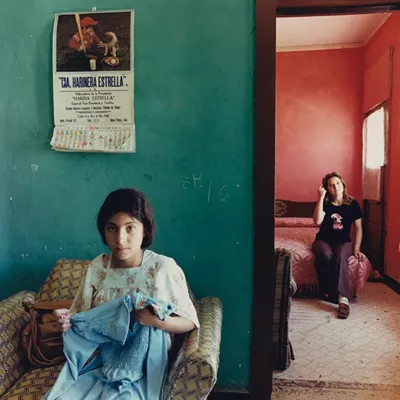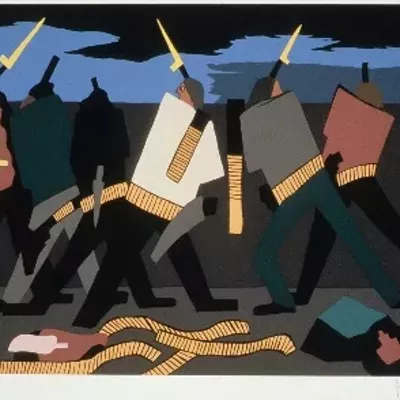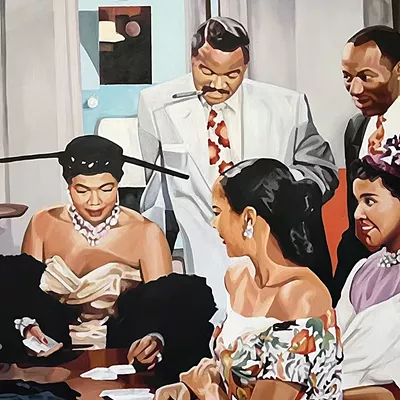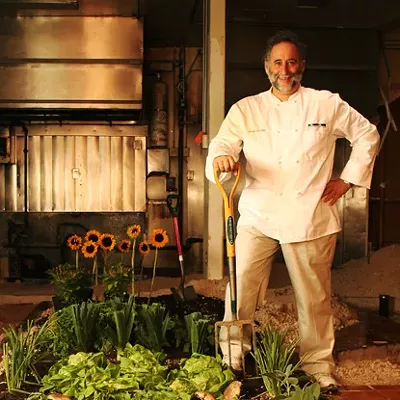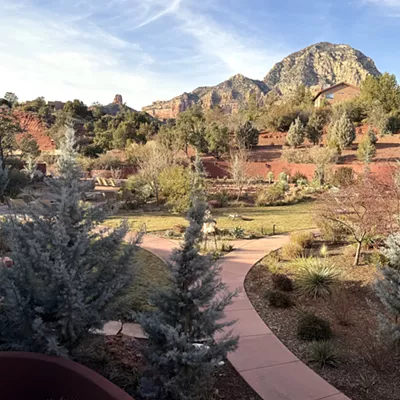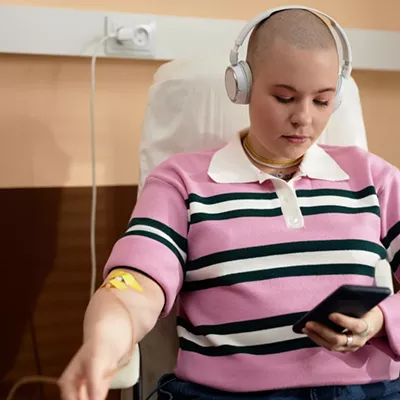The rough terrain they were crossing is part of the Buenos Aires National Wildlife Refuge, just north of the Mexican border town of Sasabe. It's hilly and rocky, and studded with prickly cacti. Trails are makeshift: Thousands of migrants' footsteps in recent years have made the paths more or less passable, but they're nothing like the carefully tended hikers' trails in places like Sabino Canyon or Mount Lemmon. If a walker concentrates on stepping around the rocks that litter the path, she runs the risk of hitting her head on one of the spiky mesquite branches that overhang the trail.
Marta Gomez Garcia, 27, a mother of two from a village in Honduras, was in the large group of strangers that hot day. She'd left her two small boys at home in the care of her husband's father, and made her way alone to the Arizona border in hopes of joining her sister Irma in North Carolina. She hadn't seen her sister in the four years since Irma left home, and she hadn't seen her husband in almost as long. He'd left her in the village with one toddler to care for and another baby on the way.
Once he arrived at the Arizona border, Gomez Garcia never heard from him again. She believes he's dead.
"I think he died in the desert," Gomez Garcia says.
But his possible death and the manifest dangers of the Southern Arizona desert didn't stop her from following her husband's example and making the same perilous journey. Honduras, she says, is "bonito pero pobre." Pretty but poor. In the United States, she could earn decent money and send some back home to her boys; they might not have a mother or a father to raise them, but they would have enough to eat.
Gomez Garcia managed to travel alone across Guatemala, and north through Mexico to Arizona, a journey of more than 2,000 miles. At Sasabe, the ramshackle border town that's now a hotspot of the migrant trade, she found a coyote, a people smuggler. Using money she got from her sister, she paid him $500 to take her across the border into America.
She wasn't in great shape for the grueling desert hike ahead. She was wearing a decent pair of gray running shoes, but she had some extra weight on her 5-foot-3 frame. She managed to walk with the group about 14 miles north of the international line, but a mile-and-a-half south of Arivaca Road, she tripped and fell, smashing her left leg against the rocks.
The fall was catastrophic. Gomez Garcia broke her femur, the long thigh bone that connects hip to knee. The pain, she says, was excruciating. Walking was impossible. Her coyote wasn't about to carry her, and with temperatures topping 100 degrees, he knew that if she stayed behind, she was likely to die a slow and painful death. So he took a page straight out of the Old West, when cowboys shot horses that went lame.
The coyote said he would shoot her to put her out of her misery.
"He was going to kill me," Gomez Garcia says, her eyes widening in horror at the memory. "I cried and told him about my two children."
Her pleas apparently worked. The coyote didn't kill her, but he and the rest of the group abandoned her in the wilderness, an act about as close to a death sentence as a shot through the skull.
"They left me all alone in the desert," Gomez Garcia says, then says it again. "They left me all alone."
The young woman spent the night huddled up on a low hill overlooking a wash, in agony from the pain in her leg. She was terrified that, like her husband, she was going to die in this strange, dangerous country, and leave her little boys orphaned.
"It was so cold," she remembers. At least she had water--no thanks to the coyote, she adds. She'd carried the water in herself.
Her luck changed with the sunrise. Early in the morning, a small band of Mexican migrants came along the same trail. They were an extended family group from the village of Tecozautla, in the central Mexican state of Hidalgo. Among them were Maria and Isaac Cruz Olguín, a young married couple, and their 2 1/2-yer-old son, Isaiah; the little boy's young uncle; and Raúl Cruz Uribe, a curly haired young man with a genial smile.
The Cruz family was horrified to find the injured woman stranded on the trail. Gomez Garcia told them what had happened. The Cruzes talked the matter over. They were already worried about little Isaiah, his uncle would later explain. The boy seemed to think he was on some kind of adventure, but the journey had already been long, hard and hot. Back home, in the Mexican highlands, temperatures rarely hit 80 degrees, even in the summer. They had never experienced anything like this Sonoran Desert heat.
The Cruzes decided to go for help. Raúl would stay behind to care for Marta while the others went to find the dreaded migra, the Border Patrol. They acted, even though they knew full well that helping this Honduran stranger would cost them their own hopes of slipping undetected into America.
"What could we do?" Raúl Cruz Uribe would ask later. "It was important that we save her life."
Around the time the Cruz group, minus Raúl, made it out safely to Arivaca Road, and planted themselves under the thick mesquites to await a passing Border Patrol vehicle, Vincent Hampel was starting his shift in Tucson.
A former Navy man, Hampel used to be a regular Border Patrol agent, patrolling Nogales on horseback and mountain bike. Nearly five years ago, he moved up to the elite Border Patrol Search and Rescue unit.
BORSTAR, as it's called, was founded in 1998, the same year the feds initiated Operation Safeguard in Arizona. (The similar Operation Gatekeeper started in California and Texas in 1994.) By erecting border fences and strengthening surveillance in border towns, Safeguard cut down on urban crossings, but it pushed migrants farther out into dangerous country like the Buenos Aires wilderness. The new search-and-rescue group was organized specifically to save migrants in distress.
"We find people looking like Dawn of the Dead," says Hampel, now a deputy commander in charge of 48 rescue agents. "They're glad to see you at that point. For that moment in their life, I was not the bad guy.
"I watch them come back to life before my eyes on a good day." He pauses. "That isn't always the case, though."
Sometimes, they die. And in fact, deaths are up all along the border. In the fiscal year that ended Sept. 30, the Border Patrol tallied 216 migrant deaths in the Tucson sector, a stretch of Arizona-Mexico border that runs 261 miles from New Mexico to Yuma. That toll is up 75 deaths over the previous fiscal year, when 141 perished.
The Tucson activist group Derechos Humanos disputes the Border Patrol figures, saying the actual numbers are far higher. Gleaning their figures from county medical examiners and Mexican consuls, they say 282 died in Arizona's deserts this fiscal year, 66 more dead than the Border Patrol claims. And that's only counting the bodies that have been found.
But BORSTAR also saves lives. In this same fiscal year, the Border Patrol made some 980 rescues. That number is 327 rescues above the 653 in the previous year.
"This was a tough summer for the heat," Hampel says. "Our rescues went up significantly from last year." And the increase, he believes, indicates "we're getting better at what we're doing."
The two women and 46 men under Hampel's command--a dozen more agents were rotated in just for the summer--work 10-hour shifts, six days a week during the high emergency days of summer, when desert temps can easily reach 110 or 115 degrees. They're all trained emergency medical technicians who've passed a rigorous physical fitness test that they must repeat quarterly.
In an hour-and-a-half, they must be able to do 40 push-ups, seven pull-ups, 60 sit-ups in under 2 minutes, run a mile-and-a-half in under 12 minutes and swim 250 yards in under 6 minutes. Then they have to carry an adult five miles. If they get through the test, they're sent to Fort Huachuca to a special BORSTAR boot camp, which has a graduation rate of just 33 percent.
"We put ourselves in the desert. We don't want to become a detriment because we're out of shape," Hampel tells me as he steers his SUV west toward Three Points.
I've come along for the day, with photographer Jay Rochlin. The issue of providing medical care to migrants in peril came to a head this summer, when two young activists with No More Deaths were arrested for transporting migrants they said were ill.
The accused, Shanti Sellz and Daniel Strauss, maintain that they have a humanitarian right to help people in trouble, but they're headed for a federal felony trial in December. Just this week, a coalition of doctors and nurses announced their support for the activists and called for the charges to be dropped. The Border Patrol insists that the activists should have notified them, arguing that its agents have the medical know-how and manpower to handle emergencies.
So we're riding along, to see BORSTAR in action.
After the hectic summer, "It's been quiet the last month," Hampel says. Early September was rainy and overcast, but with the monsoons drying up, temperatures were spiking again. Healthy migrants--the Border Patrol calls them UDAs, or undocumented aliens--can make the walk from Sasabe to Tucson in about six days if the weather's cool, Hampel says. "If it's consistently over 100 degrees for days, we see lots of problems with heatstroke and exhaustion."
About 8:50 a.m., Hampel's radio and his cell phone crackle to life in tandem. Two regular Border Patrol agents down in Arivaca have found the Cruz family. Somebody is injured out in the desert.
"It looks like we're going to have a rescue right away," Hampel says, and turns his vehicle south.
At Milepost 7 on Arivaca Road, the Cruz Olguín family sits in the shade under the mesquites, surprisingly cheerful. Little Isaiah shyly gives his name, and his mom proudly says he'll turn 3 in December. But they're surrounded by Border Patrol vehicles and agents. They're about to be loaded into a van and deported back to Mexico.
Isaiah's uncle has already set out with two BORSTAR agents to find Marta Gomez Garcia. He's the "witness" in the rescue operation, Hampel explains. A witness first gets interviewed for all pertinent information and then, if he's able, leads the rescue workers back to the victim. Occasionally, Hampel says, the effort is all for naught. Sometimes, the person rests and then, feeling better, sets out again and vanishes into the brush.
Not this time. Gomez Garcia is too badly injured to go anywhere. The two rescue agents, Dan McClafferty, a young husband and father, and Julie Gallagher, a former gymnast at Philadelphia's Temple University, find her in a mere 26 minutes, Raúl by her side. They put up a Mylar cloth to shade her and to signal the location to a Border Patrol plane overhead. Then they get to work stabilizing her.
They radio back in to Hampel: "She cannot walk. She can't bend her knee. She's a large person."
The first plan is for the rest of the team to drive into the desert as close to Marta as they can. The heavy Stokes rescue basket they'll use to carry her is too big to fit inside the only helicopter available, a small "mosquito" model. So they'll haul it by Hummer and then walk it in.
But the effort to drive ends in frustration. Hampel, in his SUV, and the Hummer driver hammer through fragile desert paths, bouncing into dry rocky washes, brushing past mesquites. They've got the guidance of a Border Patrol plane overhead, coordinates from their global positioning systems, and radio transmissions from Gallagher and McClafferty at the scene. But the longer they drive, the farther they get from their target.
"Maybe we should head back where we came in," the other rescue agent radios in from his vehicle. "I'm getting close to the border."
Hampel stops his SUV in a remote clearing and looks around. A yellow butterfly wafting by is the only sign of life. He gives a new order: Drive back to the road, and go in on foot.
By the time the desert hike begins back at Milepost 7, it's 10:20 a.m. Five agents--three BORSTARS and two regular Border Patrol agents--a rescue dog and two journalists set out southward on the rough trail at a good clip. The agents share the burden of the awkward Stokes basket. One reports that it's now 100 degrees and, despite those overhanging mesquite branches, there's little shade.
The foot search proves to be as tricky as the drive. The rescue dog, accompanied by its BORSTAR trainer, Paul Du Bois, urges the team to turn left at a wide, rocky wash. The dog stops and whines, and points its head leftward, but the agent in the plane circling overhead has a different opinion. He directs the group to the right, across the wash and up a steep hill. Inadvertently, the agents get farther and farther from the injured woman, using up time and precious water.
If they can get so turned around, it's easy to see how migrants unfamiliar with the territory--and not in the agents' prime physical condition--get into trouble.
By the time the hikers re-set their course and reach the victim, an hour and 10 minutes have elapsed. It's 11:30 a.m. Luckily, McClafferty and Gallagher have things under control. They found their patient adequately hydrated. Gallagher has asked her if she's pregnant, and Gomez Garcia answered, "I don't have a husband."
Her left thigh is swollen, but they've splinted the leg. McClafferty explains that if the woman had tried to walk, the jagged edges of her broken femur could have cut an artery and killed her.
They've also listened to her story.
"She heard from the guide that it would be a four-hour walk with water stations," McClafferty says. When she broke her leg, "the smuggler left her behind." Confirming the migrants' tale, he gestures to Cruz Uribe and Isaiah's uncle (who declines to give his name). One of them had flagged down the Border Patrol on the road, McClafferty says. "These two guys got help for her."
The crew loads Gomez Garcia up into the basket, and straps her in. They cool her down with packs of chilled water in plastic bags, and someone drapes a cloth over her face to keep out the sun.
By 11:45 a.m., the seven agents begin hiking back with their burden. They don't know it yet, but the grueling mile-and-a-half trip to the road will take an hour and 45 minutes.
McClafferty alone is carrying about 40 pounds of medical equipment, he says, and the basket weighs at least 20 pounds. He estimates that his patient weighs 180 pounds, though a nurse will later say she's closer to 130. In any case, it takes six adults to carry her, each grasping the basket with one hand, and tilting away from the litter for balance.
Every few minutes, they put the litter down and rest, then trade sides, switching from left to right. It's an awkward job, hard on the shoulders and back, like carrying a baby in a car seat, only eight or 10 times heavier.
The two captured migrants readily take their turns along with the others, grasping the basket and struggling along. After a while, McClafferty gives his patient an IV, and Raúl gingerly carries the bag of fluids aloft, walking close to her head. For a little while, at least, the agents and migrants don't have to play the parts of migra and UDAs. For a little while, they're human beings working together to save a life.
Progress is agonizingly slow. The rescuers can't easily see where they're going. Whoever is in the lead calls out warnings, "Big boulder on left!" "Tree branch!" They take the low, winding road through the wash, instead of the direct route through the hills, but the rocky wash has problems of its own. It's loaded with big rocks, and occasionally it drops steeply, forming small cliffs. One such promontory is about 5 feet high. Tilting the basket almost vertically, the agents cautiously step and slide down the rocks, trying not to jostle the patient.
At one point, Marta has tears running down her cheeks.
"Es que me duele mucho," she says. "It's just that it hurts so much."
After noon, cloud cover blocks the sun, forcing the temperature down a few degrees, but Hampel keeps an anxious watch on his troops and on the reporters. He insists that everyone keep drinking, and gives me cold water from the pack strapped to his back. All of the agents have similar Camelbaks, but soon their water is nearing depletion. Hampel orders two agents to forge ahead, to a Humvee parked somewhere in the wash, to get more water. They return with gallon jugs and small foil packs of a grape-flavored electrolyte drink, which everyone swigs greedily.
At long last, about 1:15 p.m., after an hour-and-a-half of walking, the ragtag group makes it to the Humvee. The agents hoist up the heavy litter shoulder-high and load Marta inside through a wide back door. Three agents, the dog and I climb up front into the blessed air conditioning; the other four agents, two migrants and photographer hop onto the roof; a little railing fences them in.
But we're still in hardscrabble desert, another 10 or 15 minutes from Arivaca Road. Agent Juan Delgadillo maneuvers the bulky Humvee up impossibly steep hills and through thick stands of mesquites, driving right into the branches, which bend and snap under the onslaught.
Up on the roof, everybody is jubilant, Rochlin later reports. Migrants and agents alike are slapping high-fives, congratulating each other on a job well done. But inside, strapped to her litter, still in agony, Marta Gomez Garcia has not yet moved onto joy. She begins to sob.
"No esperaba seguir viviendo," she suddenly cries out. "I wasn't expecting to live anymore."
Arivaca Road is blocked by at least a half-dozen law-enforcement vehicles, courtesy both of the Border Patrol and Arivaca Fire. A yellow Air Evac helicopter out of Tucson has alighted in the middle of the road. The copter paramedic asks the patient to rate her level of pain, from one to 10. Gomez Garcia doesn't hesitate.
"Diez," she says. "10."
The paramedic checks McClafferty and Gallagher's handiwork, and congratulates them. "This is the best job for traction I've seen," she says. The two give each other a look, and slap another high-five.
"Score one for the Irish," Gallagher whoops.
"We got the job done," McClafferty says, more sedately. "It's all human life."
Marta Gomez Garcia is loaded aboard the helicopter, for the short ride to St. Mary's, a Catholic hospital in Tucson. As she sails up into the sky, headed north away from the border, the two strangers who took pity on her, Raúl Cruz Uribe and his friend, are led toward a van for deportation.
Will he try crossing again?
Raúl flashes his trademark smile. No, he says. Not after this. He's going back to Hidalgo, "permanentemente." Permanently.
Three days later, Marta is resting comfortably in her hospital bed. Apart from the enormous cast on her leg, a great, strappy Velcro affair that goes from hip to ankle, she's looking healthy and pink-cheeked, light years from the desperate woman in the desert. She has nothing but kind things to say about the Border Patrol.
Everyone at the hospital has been kind, too. Many of the staff speak Spanish (she herself knows no English at all, she says with a grin, "nada, nada"). Hospital surgeons re-set her leg the day after her airborne arrival, and the day after that, the nurses and physical therapists had her up and walking.
The hospital allowed her to call her sister, and Irma in turn called their mother in Honduras to report the good news that Marta is alive, if not entirely well. Now Irma is en route with her husband from North Carolina. But Gomez Garcia seems to have no idea how big the United States is. The couple left by car only the day before, and Marta thinks they'll be arriving momentarily. She's been officially discharged, her nurse says, but the hospital will allow her to stay until her family arrives.
"The doctors said I have to go to a doctor in North Carolina," Gomez Garcia reports. She doesn't say what kind of work she's looking for, or what Irma does, but the doctors have given her one piece of problematic news. "They say I can't work for three months."
Still, compared to dying, a three-month wait for a paycheck is not too bad. She smiles at the memory of the kindly Raúl--"He's a nice man"--but she's dismayed to hear that he and his group were repatriated to Mexico. She catches her breath a moment when she hears why: He thought it was more important to save a stranger's life than it was for him to get into the United States.
Gomez Garcia herself has nothing more to fear from the Border Patrol. No agents will be turning up at her hospital room, nor waiting for her in the parking lot when she leaves.
"We don't go to the hospital," explains Gustavo Soto, a Border Patrol spokesman. "We focus on the border."
In one of the many ironies of U.S. border policy, as an injured person, Marta is free and clear. BORSTAR rescuers don't even inquire about the legal status of people they save.
"Our policy is not to determine the 'alienage' of the person who is injured," Soto says. "We switch roles from Border Patrol to rescuer." In the field, one of the regular agents had put it succinctly, "As far as we're concerned, she's a bird watcher who's been injured."
Critics maintain that the real reason for the policy is to shield the Border Patrol from patients' medical bills.
"If the patient is in their custody, then the Border Patrol would have to pay," says Margo Cowan, a lawyer active with No More Deaths.
Instead, St. Mary's Hospital will foot the large bill for Gomez Garcia's stay, which ends up lasting four nights and includes a major surgery. (Curiously, since she's uninsured, the hospital won't give her the crutches she needs; nor can it give her clothes. I end up zipping out to the thrift shop across the street to get her some half-price crutches and clothes.)
Between St. Mary's and its Holy Cross Hospital in Nogales, the parent company Carondelet Health Network regularly spends about $1.5 million a year on care for injured migrants, says Tom Pepping, Carondelet chief financial officer. University Medical Center, the only trauma hospital in Southern Arizona, spends millions more, he adds, since it cares for migrants critically injured in car accidents.
But thanks to a new federal program, hospitals are now eligible to get at least some of the money back. Section 1011 is supposed to compensate medical providers around the country for the skyrocketing costs of caring for illegal migrants.
"A pot of money is coming from the federal government to help with the care," Pepping says. Arizona alone expects to get $40 million a year. The bureaucracy is cranking up slowly, however, and the hospitals have yet to see any of the money.
But the hospital willingly shoulders the burden of caring for injured migrants.
"Serving those in need is part of our Catholic mission," Pepping says.
Sister Kathleen Mary McCarthy, C.S.J., Carondelet's senior vice president for sponsorship and mission, adds that St. Mary's offers compassionate care to all, rich or poor, gay or straight, old or young, legal or illegal.
"Our mission is to treat everybody with great respect, without exception," she says. "As a Catholic hospital, we take it as a serious responsibility to care for the poor. We believe in a God who has his arms around everybody."
BORSTAR's critics in Derechos Humanos and No More Deaths say that the agency doesn't always respond in timely fashion to migrants in distress. But on this particular day, almost everything went right. God may have had his arms around Marta Gomez Garcia that hot day, as Sister Kathleen might put it. But the Cruz family and Raúl Cruz Uribe did, too, and so did the copter crew, the St. Mary's doctors and nurses, and the BORSTAR agents.
After the rescue, Vince Hampel is in high spirits, even though his back is "smoked." The airplane pilot has apologized for sending the agents on the ground in the wrong direction. "Next time, we'll listen to the dog," Hampel jokes, then turns serious.
He went into law enforcement to help people, he says, and in BORSTAR, "I know deep in my heart, I'm able to participate in saving lives."
Four days after he helped save Gomez Garcia, St. Mary's delivered her into the arms of her sister, and she headed east, across America, to a new life in North Carolina.

